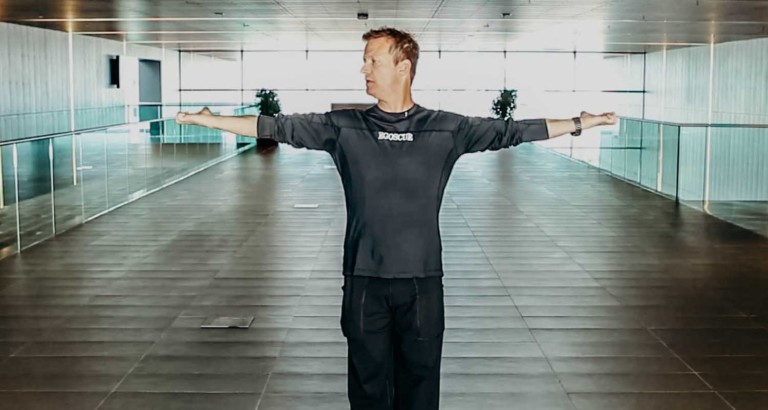
So you say to the mailman: “Can you believe it? I was gardening last summer and pulled my back out. That’s the second time I’ve done that in one month!” Or maybe you’re at the breakfast table with your partner and you mention that ankle of yours — the one you twisted again on this morning’s run. Well, recent stats prove you are not alone.
According to one recent study, nearly 50 millions Americans — or 30 percent of the population — have chronic or severe pain[ref url=”https://nccih.nih.gov/news/press/08112015″]. Another shocker: 38 percent of Americans took a prescription painkiller in 2015[ref url=”http://annals.org/aim/article-abstract/2646632/prescription-opioid-use-misuse-use-disorders-u-s-adults-2015″].
Some experts believe that proper posture and body alignment prevents injuries and chronic pain. When you are in alignment, your spine (which holds you together) remains unstressed and your muscles can work as they are supposed to. Out of alignment, and your body parts start to compensate for each other — which is what breeds trouble, and is painful to boot.
Pete Egoscue is one such expert. A Vietnam veteran, Egoscue suffered from years of hip, back, and leg injuries until he landed upon a unique exercise regimen that resolved his chronic pain. The exercises, since dubbed the Egoscue Method, address pain through proper body alignment and breathing, and boast a 94% success rate.
Here, Brian Bradley, VP of Therapy Protocol for Egoscue, shares the fundamentals of Egoscue — and how it can help you take control of your pain. (Listen to the full Bulletproof Radio podcast episode here).
Egoscue 101:
How to assess your postural alignment
When it comes to proper, pain-free alignment, first look at the position of your head compared to your hips. If your head is too far forward, it puts too much stress on the spine. Adjusting isn’t as simple as pulling your neck back, says Bradley. Instead, you need to focus on your pelvis, your center of gravity. “Once you reposition the pelvis and get a person to be more hip-driven, then the head will automatically position itself,” he explains.
Easier said than done? Bradley offers up this simple exercise to make sure your alignment stacks up correctly.
Pigeon-toe your feet, so that your toes are touching together. Tighten up your thigh muscles, which will feel like you’re sticking out your butt. Stand there for one minute with your shoulders relaxed, then have someone take a picture of you standing in this position. Notice how your head position is now in line with your ankles. This is where you want to be. Watch this video at the bottom of this story for exercises that will help you to maintain perfect posture.
A solution to painful, shallow breathing
Now notice when you breathe that your diaphragm sits at the base of your rib cage. Can you feel that your breath might actually get stuck there? Well, the nerve that runs to the diaphragm and helps you breathe comes from the neck. When your head is pitched forward more than it should be, this position puts a kink in the spinal cord, interrupting the brain’s message to the diaphragm to breathe. The result is shallow and sometimes painful breathing in a north-south motion rather than an expansive east-west motion. The diaphragm is meant to expand out, not up to help you fully empty your lungs. When you limit its range of motion, you put extreme stress on other parts of the body that have to compensate — namely, the neck and chest. This can lead to more pain…as you can see, the workings of a vicious cycle.
To get your breathing back on track and help your body find its natural alignment, put your hands around your waistline and take a deep breath in and out. Your diaphragm should expand outward (east-west) when you breathe in, instead of upward in a shoulders-up, shoulders-down motion, notes Bradley. If you practice yoga, think of these as belly breaths — letting your belly expand with each breath. Practice a few times and see how it feels.
How to get rid of pain while sitting
Use this method to relieve discomfort any time you’re stuck sitting for long periods of time (think long car rides or flights). The key here is to flatten out your lumbar spine, so roll up a small pillow or jacket and place the roll behind you at the base of your seat. Then push yourself back, pressing your tailbone against the roll. This will force your upper back into proper alignment with the seat. Remember, your spine has natural curvature, so you are honoring that.
How to use postural alignment to increase energy
Increasing energy is about improving lymphatic flow. Remember, the body pumps northbound, or upward, so if you are out of alignment, there will be inevitable build-up in the lymph system from the hips down, especially around the side of the pelvic girdle and hip joints. That’s because the fluid is trapped at the cellular level with nowhere for it to go.
To allow lymph fluid to flow everywhere it needs to go, stack those joints properly — toes, ankles, knees, and hips. To do this, first put your hands behind your head with your elbows extended back and shoulders pulled down. Notice how when you step, your entire foot strikes the floor. This is a key signal informing you that from head to toe, you are holding a posture that allows lymph fluid to flow. Continue to practice the exercises featured in the video at the end of this story until your body holds good posture on its own. Open your alignment and the fluids will flow again. Alignment for increased energy. Now, that is a nifty idea.










